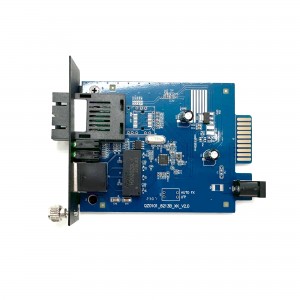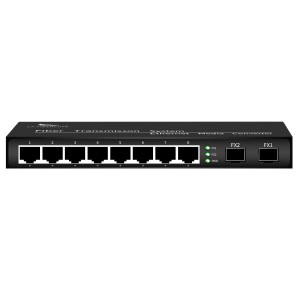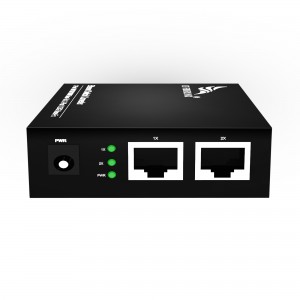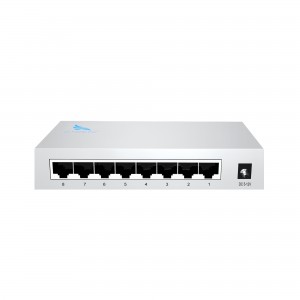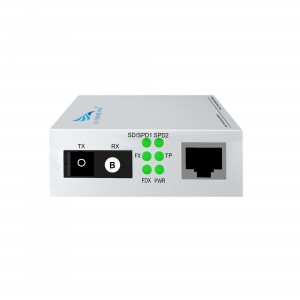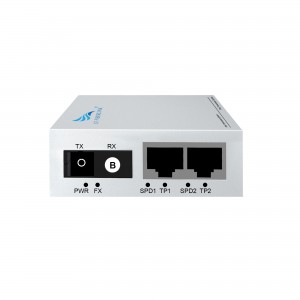2-port 10/100/1000M Plug-in Media Converter (Single-mode Dual-fiber SC)
2-port 10/100/1000M Plug-in Media Converter (Single-mode Dual-fiber SC)
Product Features:
Huizhou Changfei Photoelectric Technology Co., Ltd. launched an innovative high-performance photoelectric single-mode dual-fiber gigabit card transceiver. This cutting-edge product combines the reliability of optical transmission with the flexibility of electrical connections, making it ideal for a variety of networking applications.
This add-in card transceiver features a 2-port design that provides seamless connectivity and enhanced data transfer capabilities. Whether you need to expand your network or improve its performance, this transceiver is a powerful solution for your needs. It allows data to be transmitted and received simultaneously, ensuring efficient communication between devices.
One of the standout features of this transceiver is its wide voltage power supply ranging from DC5-12V. This provides versatile and convenient mounting options, making it suitable for a variety of settings. In addition, the ports of this transceiver are equipped with 4KV lightning protection, ensuring the safety and durability of your network infrastructure.
The transceiver also features wide temperature operation for use in extreme environments. Whether it’s sweltering heat or icy cold, this transceiver can withstand the harshest conditions. Additionally, it supports 10KB jumbo frames for faster data transfer and reduced latency.
In line with our commitment to energy efficiency, this transceiver was designed with low power consumption in mind. By utilizing advanced technologies and optimizing power consumption, it ensures cost-effective operation without compromising performance.
Operating and monitoring the transceiver is a breeze thanks to its dynamic LED indicators and 4-position dial. These features provide real-time status updates, allowing you to easily identify any potential issues. Additionally, the SC interface ensures a secure and reliable connection, minimizing signal loss and maximizing data integrity.
Designed with ease of use in mind, the transceiver offers plug-and-play functionality. You simply plug the transceiver into a compatible device or a 16-slot rack-mountable card, and you’re ready to go. This seamless integration saves you time and energy, allowing you to focus on more critical tasks.
Huizhou Changfei Optoelectronics Technology Co., Ltd. is famous for providing advanced transmission solutions and high-quality products and services. With rich experience in research and development, as well as numerous scientific research patents for optoelectronic products, we are trusted by more than 360 distributors and agents in more than 100 countries.
In a word, Huizhou Changfei Optoelectronics Technology Co., Ltd.’s optoelectronic single-mode dual-fiber gigabit plug-in card transceiver is a versatile and reliable solution to meet your network needs. With its wide voltage power supply, lightning protection, wide temperature operation, jumbo frame support, low power consumption and easy-to-use design, it ensures stable transmission and seamless connection. Upgrade your network infrastructure with this state-of-the-art transceiver and experience enhanced performance and reliability.
What This Product Does
◇ The CF-102GSK-20 is a media converter designed to convert 1000BASE-X fiber to 1000Base-T copper media or vice versa. Designed under IEEE802.3ab 1000Base-T and IEEE802.3z1000Base-X standards, the CF-102GSK-20 is designed for use with single-mode fiber cable utilizing the SC-Type connector. The CF-102GSK-20 supports longwave laser specification at a full wire speed forwarding rate. It works at 1310nm on both transmitting and receiving data.
◇ Other features of this module include the ability to be used as a stand alone device (no chassis required), Auto MDI/MDI-X for TX port, and front panel status LEDs. The CF-102GSK-20 will transmit at extended fiber optic distances utilizing single-mode fiber up to 20 kilometers.
Other Features
◇ Besides, this media converter can be used as a standalone device (no rack required) or used with CF FIBERLINK’s CF-2U16 rack for auto MDI/MDI-X in TX port in which duplex mode is automatically negotiated.
technical parameter:
| Model | CF-102GSK-20 | |
| Interface Characteristics | ||
|
Fixed Port |
1* 10/ 100/ 1000Base-T RJ45 port
1* 1000Base-X uplink SC fiber port |
|
| Ethernet Port | 10/ 100/ 1000Base-T auto-sensing, full/half duplex MDI/MDI-X self-adaption | |
|
Twisted Pair Transmission |
10BASE-T: Cat3,4,5 UTP(≤100 meter)
100BASE-T: Cat5e or later UTP(≤100 meter) 1000BASE-T : Cat5e or later UTP(≤100 meter) |
|
| Optical Port | Default optical module is single-mode dual-fiber 20km, SC port | |
| Wavelength/Distance | single mode: 1310nm 0~40KM ,1550nm 0~120KM | |
| Chip Parameter | ||
| Network Protocol | IEEE802.3 10BASE-T, IEEE802.3i 10Base-T,
IEEE802.3u 100Base-TX, IEEE802.3u 100Base-FX, IEEE802.3x IEEE802.3ab 1000Base-T;IEEE802.3z 1000Base-X; |
|
| Forwarding Mode | Store and Forward(Full Wire Speed) | |
| Switching Capacity | 4Gbps | |
| Buffer Memory | 3Mpps | |
| MAC | 2K | |
|
LED Indicator |
Fiber | FX(green) |
| Data | TP (green) | |
| Single / duplex | FDX (green) | |
| Power | PWR (green) | |
| Power | ||
| Working Voltage | AC:100-240V | |
| Power Consumption | Standby<1W, Full load<5W | |
| Power Supply | DC:5V/2A industrial power supply | |
| Lightning protection &Certification | ||
| Lightning protection | Lightning protection: 4KV 8/20us, Protection level: IP30 | |
| Certification | CCC;CE mark, commercial; CE/LVD EN60950;FCC Part 15 Class B; RoHS | |
| Physical Parameter | ||
| Operation TEMP | -20~+55°C;5%~90% RH Non condensing | |
| Storage TEMP | -40~+85°C;5%~95% RH Non condensing | |
| Dimension (L*W*H) | 98mm*75mm*2mm | |
| Installation | Desktop, CF-2U16 slot rack | |
Product Size:
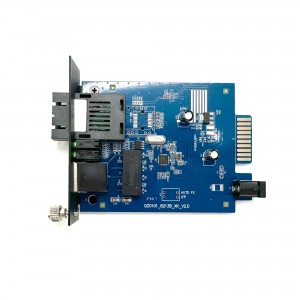
Product application diagra:

How to choose a fiber optic transceiver?
Optical fiber transceivers break the 100-meter limitation of Ethernet cables in data transmission. Relying on high-performance switching chips and large-capacity caches, while truly achieving non-blocking transmission and switching performance, they also provide balanced traffic, isolation and conflict. Error detection and other functions ensure high security and stability during data transmission. Therefore, fiber optic transceiver products will still be an indispensable part of actual network construction for a long time. So, how should we choose fiber optic transceivers?
1. Port function test
Mainly test whether each port can work normally in the duplex state of 10Mbps, 100Mbps and half-duplex state. At the same time, it should be tested whether each port can automatically select the highest transmission speed and automatically match the transmission rate of other devices. This test can be included in other tests.
2. Compatibility test
It mainly tests the connection ability between the optical fiber transceiver and other devices compatible with Ethernet and Fast Ethernet (including network card, HUB, Switch, optical network card, and optical switch). The requirement must be able to support the connection of compatible products.
3. Cable connection characteristics
Test the fiber optic transceiver’s ability to support network cables. First, test the connection ability of Category 5 network cables with lengths of 100m and 10m, and test the connection ability of long Category 5 network cables (120m) of different brands. During the test, the optical port of the transceiver is required to have a connection capability of 10Mbps and a rate of 100Mbps, and the highest must be able to connect to a full-duplex 100Mbps without transmission errors. Category 3 twisted pair cables may not be tested. Subtests can be included in other tests.
4. Transmission characteristics (transmission loss rate of data packets of different lengths, transmission speed)
It mainly tests the packet loss rate when the optical fiber transceiver optical port transmits different data packets, and the connection speed under different connection rates. For the packet loss rate, you can use the test software provided by the network card to test the packet loss rate when the packet size is 64, 512, 1518, 128 (optional) and 1000 (optional) bytes under different connection rates. , the number of packet errors, the number of packets sent and received must be more than 2,000,000. Test transmission speed can use perform3, ping and other software.
5. The compatibility of the whole machine to the transmission network protocol
It mainly tests the compatibility of fiber optic transceivers to network protocols, which can be tested in Novell, Windows and other environments. The following low-level network protocols such as TCP/IP, IPX, NETBIOS, DHCP, etc. must be tested, and the protocols that need to be broadcast must be tested. Optical transceivers are required to support these protocols (VLAN, QOS, COS, etc.).
6. Indicator status test
Test whether the status of the indicator light is consistent with the description of the panel and the user manual, and whether it is consistent with the current status of the fiber optic transceiver.







